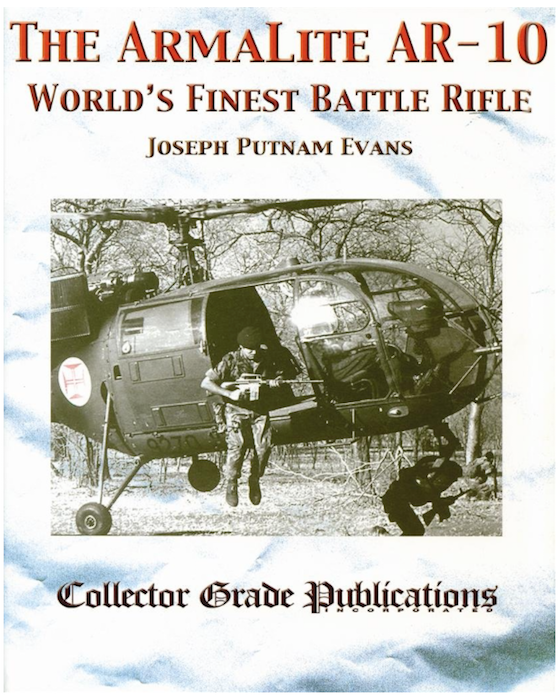While the Johnson LMG was issued in limited quantities throughout World War Two, notably to Marine Raiders, Paramarines, and the 1st Special Service Force, the US never issued web gear made for its uniquely-sized magazines. However, a small number of 12-magazine backpacks for the Johnson did find their way into US service, probably originally made for the Dutch East Indies Army.
Related Articles

Bolt Action Rifles
Vintage Saturday: Liberators
This is a pretty widely-published photo, but it sure is a good one. It also shows very clearly the US’ horrible excuse for a backpack of the time. For the record, the soldier on the […]

Book review
Book Review: The Armalite AR-10 The World’s Finest Battle Rifle
One of the topics that has been (somewhat oddly) lacking a detailed and well-researched history is the Armalite AR-10. There was a book written by a Major Pikula many years ago, but it is really […]

Accessories
Chain Mail for Machine Gunners
Chain mail appeared in a couple different forms during World War I – the most well-known is probably the mail facemasks developed for tank crews. These were intended to protect crew members from steel shards […]

That’s a respectable load out today, let alone in .30-06.
One thing about the Johnson I’ve always wondered about, and that’s why the Ordnance Department never said “OK, we’ll buy some, but they need to take the BAR magazine…”
I’ve looked at the Johnson examples I’ve had access to, and I really don’t see a major reason why they couldn’t have been adapted to the double-stack double-feed BAR magazine. You might have had to graft on a mag well, but I think it could have worked.
Ah, well… TBH, I think the post-WWI militaries of the world made some serious errors in how they approached things. They should have gone “OK, concentrate on making a standard reliable magazine in a meaningful size, that’s mass-producible… One that can go into the squad automatic -and- the individual weapon, as needed…”
Then, they should have said to the designers “Hey, your crap’s gotta work with this type-standard magazine… Period.”
Hell, you could have done different sizes, so long as the mag wells worked. 10-round for the individual weapon, 20- and 30-round for the support weapons.
And yet the armies of the time thought nothing about it because their priorities were in another place. Standardized magazines would require standardized weapons platforms across the board, which would mean SCRAPPING YOUR ENTIRE ARMORY AND REFORGING IT FROM SCRATCH. Most were stupidly comfortable with bolt-action rifles (if they’re not broke, why fix them?) and static heavy machine guns, perhaps with a magazine fed light machine gun for the random motorized platoon. And what is a small-arms system compared to the bigger issue of mechanized warfare, like tanks and warplanes? I could be wrong.
You should check out this channel called Forgotten Weapons. It will tell you that yes, you are most certainly wrong.
Mr. C, below, is right, but I also ask you to consider the difficulties of economically manufacturing spring steel — nobody got that consistently right until the US during WWII. Replaceable box magazines? Possibly disposable? Horrors! The expense! (Except in pistols, of course, and look at the exceptions — C96, Roth-Steyr, Steyr-Hahn, revolvers for the British Empire.) SMLE mags? Two to a customer, maximum. M1 Garand? One magazine spring per rifle! The Italians, Austrians, Germans, Japanese, hell, all of South America while you’re at it — Arisaka, Mannlicher or Mauser, the mag spring stays in the rifle. Note that all those box-magazine LMGs from Madsen through Bren had upside-down gravity-assisted magazines, preciously hoarded by their gunners. Even as late as 1945 Stalin allegedly personally ordered that the SKS would have a fixed magazine so soldiers would not wastefully lose removable box mags. The armies of the world were dragged kicking and screaming to the removable box magazine concept, let alone a universal box mag, and only then after their industries could produce good cheap spring steel. Because of perceived expense.
Good explanation ,to many forget you don’t need to go back all that far and thing like spring steel cheap now so to speak , damn expensive years back .
Like good quality cast that doesn’t become brittle in very cold temps .
yet, the M1 carbine hat single use magazines.
it would be interesting to compare price of pistol type magazine springs, vs. the heavier springs which are needed in a rifles mag?
The original intent of the M1 specification was for non-infantry troops only, replacing pistols in some cases. In those days, automatic pistol magazines were not disposable; the gun was issued with one and the owner was supposed to treat it as part of his weapon. They may have applied the same reasoning to the carbine used by clerks and truck drivers.